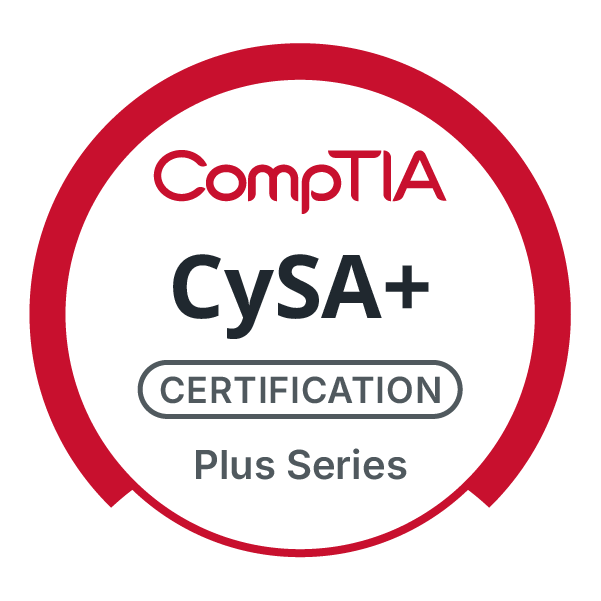
CompTIA Cybersecurity Analyst (CySA+)
CompTIA Cybersecurity Analyst (CySA+) is a certification for cyber professionals tasked with incident detection, prevention and response through continuous security monitoring. The course introduces tools and tactics to manage cybersecurity risks, identify various types of common threats, evaluate the organization’s security, collect and analyze cybersecurity intelligence, and handle incidents as they occur.
Training at a glance
Level
Intermediate
Duration
5 Days
Experience
4 years: Security
Average Salary
$112,000
Labs
Yes
Level
Intermediate
Duration
5 Days
Experience
4 years: Security
Average Salary
$112,000
Labs
Yes
Training Details
The CompTIA Cybersecurity Analyst (CySA+) certification verifies that successful candidates have the knowledge and skills required to detect and analyze indicators of malicious activity, understand threat intelligence and threat management, respond to attacks and vulnerabilities, perform incident response, and report and communicate related activity.
Acquired Skills
- Security Operations - Improve processes in security operations and differentiate between threat intelligence and threat hunting concepts as well as identify and analyze malicious activity using the appropriate tools and techniques.
- Vulnerability Management - Implement and analyze vulnerability assessments, prioritize vulnerabilities, and make recommendations on mitigating attacks and vulnerability response.
- Incident Response and Management - Apply updated concepts of attack methodology frameworks, perform incident response activities, and understand the incident management lifecycle.
- Reporting and Communication - Apply communication best practices in vulnerability management and incident response as it relates to stakeholders, action plans, escalation, and metrics.
Lesson 1: Understanding Vulnerability Response, Handling, and Management
- Topic 1A: Understanding Cybersecurity Leadership Concepts
- Topic 1B: Exploring Control Types and Methods
- Topic 1C: Explaining Patch Management Concepts
Lesson 2: Exploring Threat Intelligence and Threat Hunting Concepts
- Topic 2A: Exploring Threat Actor Concepts
- Topic 2B: Identifying Active Threats
- Topic 2C: Exploring Threat-Hunting Concepts
Lesson 3: Explaining Important System and Network Architecture Concepts
- Topic 3A: Reviewing System and Network Architecture Concepts
- Topic 3B: Exploring Identity and Access Management (IAM)
- Topic 3C: Maintaining Operational Visibility
Lesson 4: Understanding Process Improvement in Security Operations
- Topic 4A: Exploring Leadership in Security Operations
- Topic 4B: Understanding Technology for Security Operations
Lesson 5: Implementing Vulnerability Scanning Methods
- Topic 5A: Explaining Compliance Requirements
- Topic 5B: Understanding Vulnerability Scanning Methods
- Topic 5C: Exploring Special Considerations in Vulnerability Scanning
Lesson 6: Performing Vulnerability Analysis
- Topic 6A: Understanding Vulnerability Scoring Concepts
- Topic 6B: Exploring Vulnerability Context Considerations
Lesson 7: Communicating Vulnerability Information
- Topic 7A: Explaining Effective Communication Concepts
- Topic 7B: Understanding Vulnerability Reporting Outcomes and Action Plans
Lesson 8: Explaining Incident Response Activities
- Topic 8A: Exploring Incident Response Planning
- Topic 8B: Performing Incident Response Activities
Lesson 9: Demonstrating Incident Response Communication
- Topic 9A: Understanding Incident Response Communication
- Topic 9B: Analyzing Incident Response Activities
Lesson 10: Applying Tools to Identify Malicious Activity
- Topic 10A: Identifying Malicious Activity
- Topic 10B: Explaining Attack Methodology Frameworks
- Topic 10C: Explaining Techniques for Identifying Malicious Activity
Lesson 11: Analyzing Potentially Malicious Activity
- Topic 11A: Exploring Network Attack Indicators
- Topic 11B: Exploring Host Attack Indicators
- Topic 11C: Exploring Vulnerability Assessment Tools
Lesson 12: Understanding Application Vulnerability Assessment
- Topic 12A: Analyzing Web Vulnerabilities
- Topic 12B: Analyzing Cloud Vulnerabilities
Lesson 13: Exploring Scripting Tools and Analysis Concepts
- Topic 13A: Understanding Scripting Languages
- Topic 13B: Identifying Malicious Activity Through Analysis
Lesson 14: Understanding Application Security and Attack Mitigation Best Practices
- Topic 14A: Exploring Secure Software Development Practices
- Topic 14B: Recommending Controls to Mitigate Successful Application Attacks
- Topic 14C: Implementing Controls to Prevent Attacks
- Security Analyst
- Security Operations Center (SOC) Analyst
Secondary Job Roles
- Vulnerability Management Analyst
- Security Engineer
- Threat Hunter
Minimum of 4 years of hands-on experience as an incident response analyst or security operations center (SOC) analyst or equivalent experience.
Upcoming Classes
We Offer More Than Just CompTIA Training
Our successful training results keep our corporate and military clients returning. That’s because we provide everything you need to succeed. This is true for all of our courses.
Strategic Planning & Project Management
From Lean Six Sigma to Project Management Institute Project Management Professional, Agile and SCRUM, we offer the best-in-class strategic planning and project management training available. Work closely with our seasoned multi-decade project managers.
IT & Cybersecurity
ATA is the leading OffSec and Hack the Box US training provider, and a CompTIA and EC-Council award-winning training partner. We offer the best offensive and defensive cyber training to keep your team ahead of the technology skills curve.
Leadership & Management
Let us teach your team the high-level traits and micro-level tools & strategies of effective 21st-century leadership. Empower your team to play to each others’ strengths, inspire others and build a culture that values communication, authenticity, and community.
